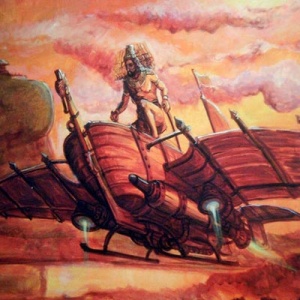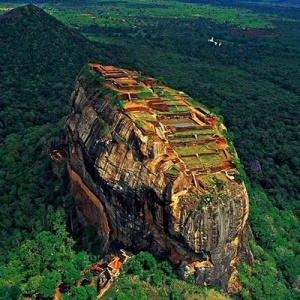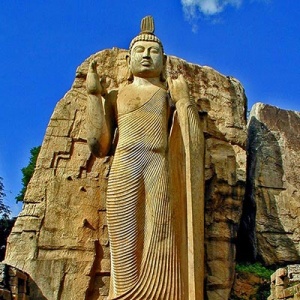


Dandumonaraya
srilanka-history
sigiriya-rock



Professor Morris Dickson once said, ‘The modern man has discovered only a little bit about the history of mankind’. According to this statement, any science in the world has not been able to reveal an accurate analysis on the subject of world’s history so far and calculate the exact origin of mankind. Nevertheless, man had to advance on a very austere path before he come to the present civilization starting from a long history beyond thousand years. To prove this, enough factors have been discovered by now.
When we analyze the history of the Sinhalese or the history of Sri Lanka, we can say that we have inherited a very long history that goes beyond the prehistoric age. The favorable climatic conditions and very rich bio- diversity found here and the natural resources situated in it, absolutely give evidences that it had been an island state which was with human settlement beyond 40,000 years. Moreover, there are enough factors found out through Archeological researches which was carried out for decades as well as academic thesis researches to prove this fact.
When we think of the island state called Sri Lanka it can be considered as a land with a proved concept born history as well as an aggregation of knowledge that went beyond it. Only very few people know that Sri Lanka was the birth place of many science such as Astrology, Sinhala Medicinal Science (Traditional Medicine), the elements of Atomic Technology, Engineering and Irrigation Technology and Air plane Technology that make the modern world confused. The current Sri Lanka which was called as ‘Sinhale’, ‘Helaya’, ‘Heladweepa’was not mere ‘A pearl of the Indian Ocean’ but it was a proud island with a historical environment that exceeded India too. Sri Lanka is a land that has noted a landmark in the world map with a written history.
About hundred years ago, from the time written language came into existence, out of the necessity of many foreign nations with the intention of hiding Sri Lanka’s real proud history, when writing the history it has been distorted. Because of that, what the present generation has received is not the real history of Sri Lanka but it is a distorted and trivialized history.
According to the so called history of Sri Lanka, the first ancestor of Sinhala nation is a man with a half shaved head who was expelled from India. The purpose of the foreign diplomats and counterfeit writers who came to Sri Lanka before it gained independence, was to trivialize its true history. Fortunately, due to the great attempts of the patriotic and knowledgeable archeologists and anthropologists who were born in Sri Lanka, such false opinions have been smashed and truth revealed.
According to Raj Somadewa, Professor in Archeology, there are great many evidences that Homo sapiens who landed at Sri Lanka about 125000 years ago, established human settlement in it. Some of the places they landed in Sri Lanka at that age are Bundala,Pathirajawela and Minihagalkanda in Hambantota District in the South. From then on, humans started living in this country.
It is believed that the Homo sapiens appeared only in Africa about 150,000 years ago and they began to make settlements in other countries leaving Africa. Some of those moved towards Europe in one end and some to Russia and some towards Asia in another end. The place a little distance away from Block 02 of Yala which is close to Southern Coast of Sri Lanka has been identified to be the first place they landed Sri Lanka for the first time. The evidences that found out from the excavation sites prove that the earliest humans lived respectively in Hambantota125000 years ago, in Bundala 74000 years ago, in Pahiyangala 41600 years ago, in Kithulgala 25000 years ago, in Batadombalena 28500 years ago and in Maatota(Mannar)3830 years ago. Accordingly, it is obvious that Homo sapiens had been living all over the island of Sri Lanka, making their settlements.
In an excavation on the site of Bellan Bedi Pellessa in Balangoda done by Dr. P.E.P.Deraniyagala in1956, pieces of bones belonging to 36 human bodies had been discovered. The chronology of these bones is said to be about 12000 years. In an excavation in Kuragala, parts of human skeletons had been found which dated10000 years. In 1989, the parts of bones found in an excavation carried out close to Sigiriya is about 5913 years old. According to Diana Hockey, the arrangement of teeth of the Asian ancestral human who lived during the initial period of Holocene is very similar and identical with the tooth skeleton of the humans found in Sri Lanka. So, it is obvious that the history of Sri Lanka exceeds even the history of India.
Beyond that, our attention should be paid to the technological skill related to Hela (Sinhala) creative arts. There are some places that give evidences on the wonderful stage of indigenous technology even today, that the present generation that is praising the western technology should visit. At Morawewa area in Horowpathaana you can see several pillars made of stone kept on some boulders. On the top of some of these stone pillars, iron spikes have been immersed. When looking into these it has been discovered that they are lightning conductors. Professor Raj Somadewa says that these stone pillars with lightning conductors are kept on some high places on the land in order to protect the people who are in a large plane. This means that those who lived in the past, had a great understanding of technology. Likewise, many places you find in Kurunegala District, where big triangular stones are positioned on large rocky planes demonstrate such a technology. Even today, according to newspaper reports, many lightning accidents occur in North-West Province and North-Central Province. So those creations are fine examples to highlight the wideness of the knowledge the ancient architects had.
Although the western countries are reluctant to accept that Sri Lanka had a long history of metal industry, they were only learning the extraction of iron, during the Industrial Revolution, when Sri Lankans had started to make iron wares and tools long before. According to Professor Raj Somadewa, they have found iron wares from a tomb at Beragala in Haputhale which were about 4200 years old. It is said that the world’s oldest evidence for iron is found in 1600 BC but in our country such an evidence is found in 2400BC. Therefore, Sri Lanka has the oldest evidence for discovering iron in the world. Evidences are still emerged that Sri Lanka did iron extraction, made equipment and tools out of iron and used those things for various purposes. The surgical instruments found at Aalaahana Pirivena (monastery for Bhikkus) are about thousand years old. Making such sharp instruments out of iron is also a fine proof for that we didn’t learn the field of medical surgeries from the West.
According to the geological factors, Sri Lanka remained as an autonomous island separated from the Indian mainland 7000 years ago. During that period of 7000 years, surrounded by the great ocean as an isolated island Sri Lanka had its own traditions and aggregation of vast knowledge which paved the way for its national identity. Hence, Sri Lanka is not a country which is fed on Indian culture and Indian technology but a country which gradually developed with an identical civilization. Therefore, the present generation should actually do a study about the depth of the above mentioned history. History means the basis of the present. History is the creator of the whole thing. We cannot live deprived of history. So, we should all read up our proud history logically.
The identity of the citizens living in the society can only be proved by being aware of the history and heritage of the country. The history of Sri Lanka expands into the past more than 125000 years. But the history learned by us or mentioned in the books is only about 2500 years long. Sinhalese History has been curtailed up to the level that the settlement of Sinhala Dweepa, the establishment of Buddhism, irrigation technology and the transformation that followed in religious, cultural and social fields are all due to Vijaya and his700 followers who expelled from India and the advent of Arahant Mahinda Thero. Somebody may wanted to do this. Anyway, what we have learnt so far is a distorted history.
Because Sinhala language was spoken, this country was named as Sinhala Dweepa and also it was named as Sinhala Rata since time immemorial. According to Professor Raj Somadewa in an epigraph found in a cave at Tamilnadu in India, it is mentioned that Sri Lanka was called as Sinhala Dweepa at that time.
There were a number of reasons for distorting and suppressing our history. From the far off past, because of foreign invasions that happened from time to time our history and heritage were destroyed. Some places were destroyed beyond all recognition. These are not accidental incidences. They are the great crimes purposely done. The name Rawana is not an unfamiliar name to Sri Lankans. The matter that how modern Sri Lankans who have not seen a photo or at least a painting of Rawana know about him is a thing that should be considered gravely. However, there is a lot of information that Rawana is not legend or a mere superstitious concept and that actually there was a king called Rawana who ruled Sri Lanka in the prehistoric age. There are many evidences to prove that he was a brave, powerful and mighty king and he had a great military strength. Astronomy, Sinhala Medicine, Astrology, Atomic Technology and Airplane Technology are some of them among the many things he endowed the world. We are reluctant to accept or seem to be unaware of the fact that we had our own culture and art technics during the era the Lord Buddha was living. To ascertain that fact we have enough evidences. When we talk about Art and Music it is impossible for us to do so without mentioning the name of India. But even before India could think of such things our forefathers had engaged in those things thousand years ago. The musical instrument called ‘Rawana Haththa’ made by King Rawana is a fine example for this. Due to various reasons, our all capabilities have been suppressed. Nevertheless, during the reign of King Rawana and before that Sri Lanka was a powerful country with a huge military power, large manpower and technological power which can conquer even the neighboring countries. That is why even India at present too, admires the ‘Dandumonaraya’(an aero plane) made by King Rawana and has named the places where it landed in India (a forest area in North India).
From the 13th century on wards, when European nations were aiming to capture India, they paid their whole attention towards Sri Lanka which is a sea central point in the Indian Ocean. In the 15th century, a crew of Portuguese sailors landed Sri Lanka and deceiving the King of Kotte gained a part of Sri Lanka under their control. Then, the King had to seek the support of the Dutch to dispel the Portuguese from Sri Lanka. Next, the Dutch acquired the commercial dominance of this country and a considerable part of administration of it. Then, the people of this country raised their objection to the Dutch because they began to undermine Buddhism. After that, the British who gained the coastal areas of Sri Lanka under their control, acquired the administration of the whole country by signing the Up country Convention (Udarata Givisuma) in 1815 and arrested the King of Sinhalese. Later, the native people waged two rebellions in 1818 and1848 against the British, but they brutally crushed them and killed and imprisoned or dispelled the native chiefs.
Putting an end to that colonial era, our neighboring country India received the independence from the British Empire in 1947. Therefore, the struggle for independence in Sri Lanka too came to a decisive position. As a result of that, the native members of the then State Consultation Council including Mr. D.S.Senanayaka resolved a proposal asking the freedom for Sri Lanka. Thus, Sri Lanka gained its independence on the 4th February 1948. After that, amidst various political disorders and civil conflicts Sri Lanka became a completely sovereign Republic in 1972. Though this country with a proud history and Sinhalese culture enriched with agro- economy was handed over to the British in 1815, they returned it to us in 1948 after destroying the Sinhalese culture, heritage and all that.
When we take all the above mentioned matters into our consideration, we belong to the generation coming from the Homo sapiens that landed Sri Lanka about 125,000 years ago and not to a history of 2500 years. Because of that, we all inherit the creative potential, wisdom, that trend and that genes that come from our forefathers who lived in the pre- historic age. So it is all our duty to have a knowledge about our rights to this country and its national pride. We must set the foundation for a better future receiving the know-hows from our great heritage and having a good understanding about the modern world.
Only a person who has well studied the Archeological sites of Sri Lanka and prosecuted in Anthropological and Archeological Researches knows that the history which the present Sri Lankans believe is a false superstition and a completely different, long and wonderful, historical story is still buried under this land of Sri Lanka. We all should remember that it is only we ourselves can unearth that great history.


